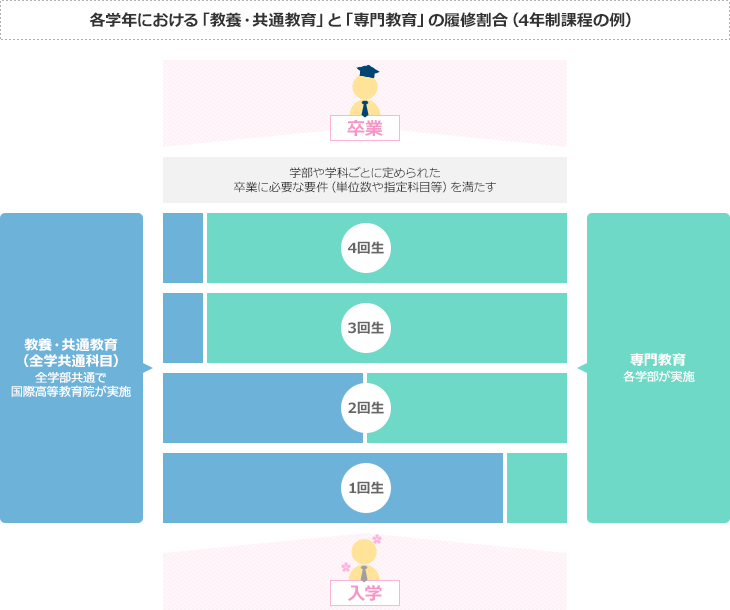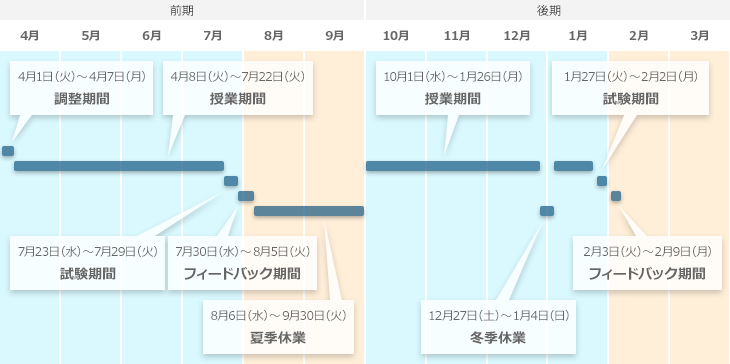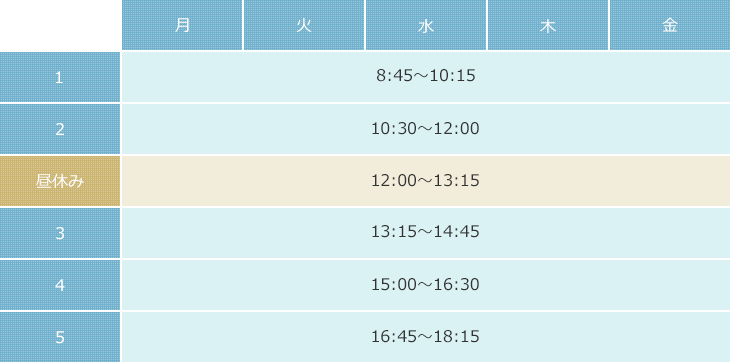学びに関すること
京都大学の教育体系
京都大学の学士課程教育の体系は、教養・共通教育と専門教育(※)により構成されています。専門教育はそれぞれの学部で実施されます。これに対して教養・共通教育はすべての学部の学生を対象に国際高等教育院が実施しています。
本学の教養・共通教育は、以下の目的のために実施しています。
- 自分の選んだ専門分野以外の学問に触れ、多様な問題関心や学問的方法論を理解する
- 専門教育の課程で必要とされる基礎的な学力や知識・技能を習得する
- 国際化した社会において学問研究に従事し、あるいは、社会の様々な分野で活躍するために、しっかりとした国際的視点とともに、十分なコミュニケーション能力を身につける
どの学部に入学した場合も、教養・共通教育として「全学共通科目」の履修が求められ、専門教育の前に、もしくは専門教育と並行しながら「全学共通科目」を学ぶことになります。全学共通科目について各学部・学科ごとに定められた卒業に必要な要件(単位数や指定科目等)を満たすように科目を履修し、単位を修得することが必要です。入学予定者サイトの「学びに関すること:卒業に必要な全学共通科目の単位数について」もしくは全学共通科目履修の手引きの「各学部の修得すべき全学共通科目の単位数(平成28年度以降入学者)」を必ず確認してください。
全学共通科目は、その内容に応じて科目群を編成しています。詳しくは科目設計の目的をご覧ください。
※専門教育とは、各分野の専門的知識や学問の方法を身につけることを目的として各学部が実施するものであり、その教育課程は、各学部の理念とカリキュラムポリシーに基づき決定されています。

学年暦と授業時間
京都大学では1年を前期と後期の2つの学期にわけるセメスター制を採用して授業を行っています。全学共通科目では、各期を14週の授業期間、1週の試験期間、1週のフィードバック期間(※)で構成しています。授業の開始から終了までの日程は下図のとおりです。
※フィードバックは、授業の中で得た新しい知識がどのくらい定着しているかを、教員からの講評や教員への質問を通じて自ら振り返ることで気づき、今後の学習に活かすことを目的に、1回分の授業として実施されます。

また、授業の時間帯は下図のとおりです。月曜日~金曜日の各日に5コマ、1週間に5×5の25コマの授業開講枠があります。

授業日程の詳細はこちらのページをご確認ください。
大学における単位制度
大学では授業の時間と授業形態を基準として科目ごとに発給される単位数が定められています。通常、授業は90分(1コマ)週1回行われ、一学期に15回、つまり90分授業×15回で実施されます。1コマの授業の単位数はその形態に応じて下記のとおり定められています。
-
講義、演習系科目
-
[授業時間 × 回数※]
90分 × 15回 -
[単位数]
2単位
-
[授業時間 × 回数※]
-
実験、実習系科目
-
[授業時間 × 回数※]
90分 × 15回 -
[単位数]
1単位
-
[授業時間 × 回数※]
| 授業形態 | 授業時間 × 回数※ | 単位数 |
|---|---|---|
| 講義、演習系科目 | 90分 × 15回 | 2単位 |
| 実験、実習系科目 | 90分 × 15回 | 1単位 |
※実験・実習系科目は講義・演習系科目に比べ自習時間の比率を高くとれないため単位数が少なくなっています。
卒業に必要な単位から見ると大学での授業時間数は高校に比べて少ないと感じるかもしれませんが、これには理由があります。大学設置基準という法令で1単位は45時間の学修を必要とする内容をもって構成することが標準と定められ、授業時間に加えて授業時間外に必要な学修等を考慮することとされています。つまり、自学自習で学ぶことを前提に単位数の設定がなされているのです。大学では、受動的に授業を受けるのみでなく、能動的に自ら学び、授業で得た知識を基に自ら考えることが必要です。
単位を修得するには、期末試験、レポート試験あるいは平常点などの評価で科目に合格することが必要です。全学共通科目の試験・成績については全学共通科目の授業及び試験・成績を参照してください。各科目でどのように成績評価が行われるかについては、シラバスで確認することができます。
授業外での予習・復習の時間を確保できるように、それぞれの学部で一学期に履修できる単位数の上限が定められています(キャップ制と呼ばれることがあります)。あまりに多くの科目を履修すると、一日の生活時間の中で予習・復習に当てる時間、自ら考える時間がなくなるからです。入学予定者サイトの「学びに関すること:卒業に必要な全学共通科目の単位数について」もしくは全学共通科目履修の手引きの「各学部の修得すべき全学共通科目の単位数(平成28年度以降入学者)」で確認することができます。みなさんはこの上限の範囲内で、以下の説明や学部ガイダンス等を参考にしながら全学共通科目・専門科目の履修計画を立てなければなりません。
全学共通科目でのクラス指定科目
全学共通科目の授業を実施するうえで、各学部・学科ごとに約40名を基準とするクラスを編成します。
各学部・学科の卒業要件で必修または選択必修に指定、あるいは履修が推奨されている(※)授業科目や履修者数の調整が必要な授業科目は上記のクラス単位であらかじめ時間割を組みます。このクラスごとに実施される授業をクラス指定科目といいます。クラス指定科目は、ほとんどの科目で学部・学科ごとに同じ時間帯で開講しますが、外国語科目や一部授業科目の時間割は、クラスによって異なるものもあります。各学部・学科のクラス指定科目時間割は、入学予定者サイトの「シラバス(授業内容)・時間割」または下記「授業開始前の授業選択」の項に掲載している「全学共通科目クラス指定時間割・専門科目時間割」から確認してください。
※必修科目は、卒業するために必ず単位を修得しなければなりません。選択必修科目は、学部(学科)が指定する科目の中から一定数以上の単位修得が求められます。履修が推奨される科目は、卒業要件上、単位修得が必須ではありませんが、専門教育の基礎となるなどの理由から学部(学科)が推奨しています。
クラス指定科目以外の全学共通科目を自由選択科目といいます。自由選択科目はクラスに関係なく自由に選択して履修できます。
外国語科目についてはまず、どの言語を履修するか選択する必要があります。詳細は、以下の「授業開始までの科目選択」をご覧ください。
シラバスについて
授業についての詳細な計画を示したものがシラバスです。科目を選択する際の手がかりとなり、さらに科目を実際に学んでいくうえで学修等を進めるための指針となるものです。自由選択科目の履修についてはシラバスを活用して履修する候補科目を選択してください。
シラバスに表示している教室名について、吉田南構内の主な教室は建物名称を省略しています。
2共 ・・・・・吉田南2号館
4共 ・・・・・吉田南4号館
共北・・・・・吉田南総合館北棟
共東・・・・・吉田南総合館東棟
共西・・・・・吉田南総合館西棟
共南・・・・・吉田南総合館南棟
総人・・・・・総合人間学部棟
教育院棟・・・国際高等教育院棟
情報メ・・・・学術情報メディアセンター(南館)
南・・・・・・吉田南国際交流会館
建物の構内配置図はこちら
時間割の構成のしかた
以上の説明を踏まえて、自身の時間割を考えていきましょう。
大学では自分で何を学ぶかを決めて科目を選択する必要があります。将来の専攻分野や自身の学習目標を意識して履修計画を立ててください。特に1回生前期は、大学生活を含めて大学での学修態度を身に付ける大切な時期です。各科目をしっかりと学ぶために無理のない学習計画、適切な数の履修登録、予習・復習時間の確保が必要です。
時間割は皆さんそれぞれ異なりますが、時間割を考えて履修登録する手続きは共通です。1回生前期の履修登録科目が決定するまでのおおまかな流れを説明します。
3月中
入学予定者サイトを通じて卒業要件や時間割の大枠を確認しておきましょう。外国語選択・ILASセミナーへの申し込みは入学予定者サイトで期日までに手続きしてください。
(1)卒業までに修得が求められる全学共通科目の単位数を確認しましょう。
- 学部・学科により卒業までに修得が求められる全学共通科目の単位数及びその内訳が異なりますので、第一に確認してください。入学予定者サイトの「学びに関すること:卒業に必要な全学共通科目の単位数について」もしくは全学共通科目履修の手引きの「各学部の修得すべき全学共通科目の単位数について」で確認することができます。
- 一学期に履修できる単位数の上限を確認しましょう。この範囲内で、自身の学習計画に沿って前期に履修する科目を決めることになります。
- 理学部所属の皆さんは、「理学部教科の手引き」で専門基礎科目に分類される科目を確認してください。工学部所属の皆さんは、「工学部履修要覧」で学科が指定する自然科学科目群の科目を確認してください。
(2)クラス指定時間割を確認しましょう。
- 初修外国語の指定クラスの他、3月の時点では所属クラスが決まっていないため、同じ学部(学科)内でも所属クラスにより指定曜時限が異なる科目の時間割は確定していないことに注意してください。
- 空いている時間帯で自由選択科目の履修を検討しましょう。
- 全学共通科目クラス指定時間割・専門科目(必修科目や特に学部が履修を推奨する科目)時間割及び学部(学科)履修指導(日本語版のみ)
(3)外国語履修科目選択届を提出しましょう。(全員必須・入学予定者サイトで申し込み)
3月25日(火)17時締切
- 京都大学では、すべての学部で2言語以上の外国語科目の履修を求めています。どの外国語科目の単位が、卒業に必要な単位として算入されるかは学部・学科によって異なりますので、これを勘案して、学ぶ言語を選択してください。
- 教育職員免許状を取得する場合には、教科に関わらず、英語、ドイツ語、フランス語、中国語、ロシア語のいずれかから、2単位を修得する必要があります。教免科目についての詳細は、所属学部教務掛や教育学部教職教務掛で確認してください。
- 外国語科目履修選択手続を授業開始前に行う理由は、選択した言語をもとに外国語科目のクラス編成を行うためです。英語、ドイツ語、フランス語、中国語、スペイン語、アラビア語を選択した場合は履修クラスを指定します。クラスの変更はできません。
- ロシア語、イタリア語、朝鮮語についてはクラス指定科目ではなく、自由選択科目として開講します。
- 日本語(外国人留学生のみ)を選択した場合の手続は別途案内します。
- それぞれの外国語科目の特徴や授業についての説明は英語教育とE科目について及び初修外国語についてを確認してください。
(4)ILASセミナーの抽選に申し込みしましょう。(希望者・入学予定者サイトで申し込み)
3月25日(火)17時締切
- ILAS(アイラス)セミナーとは・・・こちら
- ILASセミナーは授業ごとに定員を設定しているため、受講者選抜のための抽選を行います。抽選申込手続は、事前にILASセミナーについてで科目概要や予備登録日程などを確認してから行ってください。
- ILASセミナーは主として前期5限に開講されます。この時間帯にはクラス指定科目は原則として開講されません(ただし一部例外があります)。また、初修外国語のクラス指定科目もILASセミナーと重なって割り当てられないよう調整されます。ただし、以下の科目を履修する場合は、ILASセミナー(ILAS Seminar-E2)の開講曜時限と重複する可能性があり、どちらか一方の授業しか履修できません。
- 自由選択科目である外国語科目(ドイツ語及びフランス語の6Hコース、フランス語8Hコース、英語ライティング-リスニング上級、 ロシア語、イタリア語、朝鮮語)
- 各学部が実施する専門科目(やむを得ず、5限に専門科目を実施している学部があります。)
- 1限~4限に開講される一部のILASセミナーとクラス指定科目や専門科目等
- 重複により履修できなくなることを避けるため、専門科目、クラス指定科目、自由選択科目として開講される外国語科目の時間割を入学予定者サイトの「シラバス(授業内容)・時間割」で確認し、そのうえで希望するILASセミナーの抽選申込手続をするようにしてください。
(5)統合型複合科目の抽選に申し込みしましょう。(希望者・入学予定者サイトで申し込み)
3月25日(火)17時締切
- 統合型複合科目とは・・・こちら
- 統合型複合科目も授業ごとに定員を設定しているため、受講者選抜のための抽選を行います。抽選申込手続は、事前に統合型複合科目についてで科目概要などを確認してから行ってください。
- 統合型複合科目は週2コマでの開講となります。重複により履修できなくなることを避けるため、専門科目、クラス指定科目、自由選択科目として開講される外国語科目の時間割を入学予定者サイトの「シラバス(授業内容)・時間割」で確認し、そのうえで希望する統合型複合科目の抽選申込手続をするようにしてください。
授業開始まで
実際に時間割を作成する期間になります。履修人数制限科目の抽選申込もこの期間ですので、申し込みを忘れないようにしてください。時間割の作成や履修登録はKULASIS(クラシス)上で行います。操作で分からない点があれば、全学共通科目学生窓口まで問い合わせてください。
(1)KULASISの「履修登録」ページで時間割を確認しましょう。
- KULASISとは・・・こちら
4月1日以降、全学生共通ポータルにログイン後、KULASISにアクセスすることができます。 - 時間割には、必修科目、クラス指定科目、外国語(英語・ドイツ語・フランス語・中国語・スペイン語)の指定クラス、ILASセミナー抽選申込・統合型複合科目抽選申込で当選した科目が予め登録されています。
- 所属クラスにより指定曜時限が異なる科目の時間割も確定しています。ただし、一部のクラス指定科目は一クラスの中で、あるいは所属学科で指定クラスが分かれるため、複数時間割に登録されているものがあります。KULASIS→お知らせ→共通教育教務情報に掲載している「2025年度前期「クラス指定科目」の履修について」で指定クラスを確認してください。
- 一学期の履修上限単位数と現時点で何単位時間割に登録されているか表示されます。
(2)ILASセミナーの先着順申込を受け付けます。(希望者・KULASISで申し込み)
4月2日(水)9時 ~ 4月4日(金)17時まで
- ILASセミナー・ILAS Seminar-E2の当選科目がない場合、「ILASセミナー」ページで追加申込ができます。
(3)履修人数制限科目の抽選申込を受け付けます。(希望者・KULASISで申し込み)
予備登録期間1:4月1日(火)8時 ~ 4月2日(水)24時まで
予備登録期間2:4月3日(木)19時 ~ 4月4日(金)24時まで
- 教室定員を超える多数の履修希望者が予想される等の理由で履修人数を制限する科目があります。履修人数制限が行われる前期・通年開講科目の履修を希望する場合は、この期間にKULASISの履修(人数)制限ページから申し込んでください。
- 前期に履修人数制限を実施する科目は、3月21日頃に入学予定者サイトの「お知らせ」に掲載します。
- 教室の収容人数の関係上、大多数の全学共通科目について履修(人数)制限を実施する可能性があります。履修の機会を逸することのないよう、履修を希望する科目について履修(人数)制限が行われるか否かを必ず確認の上、履修(人数)制限科目については、忘れずに予備登録を行ってください。
- 申込期間が終了後、申込者数が履修人数(定員)を超過した科目については抽選を行い、履修許可者を決定します。申込者数が定員を超過しなかった科目については申込者の履修を許可したうえで、空き定員について先着順で申し込みを受け付け、履修を許可します。予備登録期間2には、予備登録期間1で定員を充足しなかった科目のみ申し込みを受け付けます。
- 申し込みにあたっては、優先して履修すべき科目(クラス指定科目や1回生に配当されている専門科目)の時間割との重複に注意してください。KULASISの履修登録ページの公開は4月2日です。
- 履修人数制限科目の一部には、特に学習意欲の高い学生に履修の機会を与えるため、担当教員が学生に事前課題を課し、抽選時に優先的に当選させてよいと判断される学生を推薦する科目があります。事前課題を提出した結果、担当教員の推薦を受けた学生は、抽選時に優先して当該科目に当選します。対象科目は3月21日頃、入学予定者サイトの「お知らせ」に掲載する予定です。対象科目一覧のほか、事前課題の提出フォーム(Google Form)および提出期間等を案内します。なお、事前課題の提出は任意です。対象科目の履修を特に希望する場合は提出してください。また、事前課題を提出した科目については、あわせて申込期間にKULASIS の履修(人数)制限ページからも申し込んでください。履修(人数)制限ページから申し込みを行わなかった場合は、事前課題の提出は無効となります。履修(人数)制限ページでは、同じ名前の科目、同じ曜時限に開講される科目は1つしか申し込めない制限を設けています。事前課題の提出にあたってはこのことを考慮してください。
(4)「全・英」の表示があるE3科目の予備登録を受け付けます。(希望者・KULASISで申し込み)
4月1日(火)~4月4日(金)(各日8時~18時まで)
- E3科目とは…こちら
- 「全・英」の表示があるE3科目は、学術的言語技能の向上を目的とし、1開講期につき1科目を上限として、学部1回生から履修することができます。履修希望者は、該当科目についてKULASISの外国語予備登録ページ(「英語」のカテゴリー)から、「予備登録」を行ってください。
- 先行実施される学部2回生を対象とした予備登録の結果、所定の履修人数(定員)に達しなかった科目についてのみ、予備登録することが可能です。
(5)新入生ガイダンス、学部のガイダンスに参加し、履修科目を選択するにあたって情報収集してください。
- 新入生ガイダンスは、動画を配信するオンデマンド型で実施します。各自都合のよい時間に視聴してください。
(6)履修人数制限科目の抽選結果は当選した科目が時間割に登録される形で発表されます。
- 予備登録期間1の当選科目の登録は、4月3日(木)夕方頃、予備登録期間2の当選科目の登録は4月7日(月)夕方頃を予定しています。抽選に外れた場合でも、先着順申込受付期間1から3のそれぞれの期間に追加申込をする機会があります。
- 抽選申込の結果、定員に空きがある科目は先着順で履修申込を受け付けます。履修人数制限実施科目の先着順申込受付期間1は、4月8日(火)7時から4月14日(月)19時までです。
定員に空きのある統合型複合科目についても、これ以降、他科目と同日程で先着順申込受付を行います。
履修登録確定まで
(1)授業に参加しましょう。
- 前期の授業は4月8日(火)から始まります。履修登録が確定するまでの間も授業は進められます。クラス指定科目、予備登録に当選した又は先着順で申し込みしたILASセミナーや履修人数制限科目など、履修することを決めた科目は初回授業から出席してください。
- 授業教室はシラバスに記載しています。
- 教科書は京都大学生協で取り扱っています。京大生協教科書販売ページ
- 教科書は授業を受ける上で原則必要です。参考書等は必須ではなく、学習を深めるための位置づけですので、購入はせずに必要に応じて大学図書館で参照するなどしてもよいでしょう。
(2)履修科目を取捨選択しましょう。
- 履修人数制限が行われていない自由選択科目(クラス指定のないロシア語・イタリア語・朝鮮語を含みます)は、各自で時間割に登録してください。
- ILAS Seminar-E2を追加で申し込みしたい場合は、先着順申込期間中に申し込みしてください。
- 履修人数制限科目の抽選に当選した科目であっても、初回授業を受けてみて履修を取りやめることがあるかも知れません。その場合には時間割から削除してください。その科目の履修を希望する他の学生さんが履修の機会を得ることにつながります。
- 履修人数制限実施科目の先着順申込受付期間2は4月15日(火)7時から4月18日(金)13時までです。抽選申込で定員を充足した科目であっても、履修を取りやめた学生さんがいて定員に空きができればこの期間に申し込めるようになります。
(3)履修登録期間中に、忘れずに履修登録を確定しましょう。
- 原則として同じ科目名の科目は一学期に1科目しか履修することができません。
- 一学期に履修できる単位数の上限を超えて登録を確定することはできません。
- 上2つに該当していると登録確定のボタンを押すことができませんので、制限に反しないように履修科目を調整の上、期間内に登録を確定してください。
(4)履修登録確認・修正期間中に、再度履修登録を確定しましょう。
- 履修人数制限実施科目の先着順申込受付期間3は、4月23日(水)7時から4月24日(木)13時までです。
- 先着順申込科目だけでなく、履修登録確認・修正期間に科目を追加・削除したら必ず登録を確定してください。履修登録確認・修正期間の確定を忘れた場合には、履修登録期間に確定したとおり(履修登録エラー科目は除く)に履修登録科目が確定されます。
以上が一般的な時間割の構成のしかたです。全体の流れを把握して、一つ一つ着実に確認・手続きを進めてください。履修登録の注意事項は、全学共通科目履修の手引きの「履修登録について」をよく確認してください。
入学して早々に初めての履修登録手続きがあり、戸惑われる方も多いかも知れません。質問があれば全学共通科目学生窓口や所属学部の教務掛へ相談してください。
全学共通科目への意見箱ページでも質問を受け付けています。
なお、全学共通科目学生窓口でよく受ける質問はQ&Aページにまとめています。





